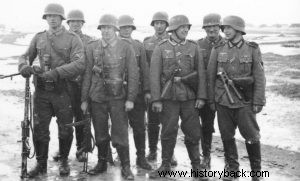
The battle group, the various military manuals state, is the smallest tactical battle formation. A number of groups make up a platoon, platoons companies, companies battalions and so on. Consequently, the squad is the cell of an army, its smallest functional unit that can undertake a specific mission alone or in cooperation with other squads.
The names of famous armies, corps, divisions that made history are still heard. Behind all this, however, is the collective effect of the small, anonymous battle groups, the small cells that actually decided the outcome of the battles based on the plans of the higher echelons.
This of course also applies to all the armies that operated in World War II, but also in previous wars. The battle group as a concept has been around for a long time under many different names. It has always been the smallest tactical part of an army, only that in previous times it did not necessarily have the ability to develop autonomous action, due to the tactics followed.
Thus in ancient Greece the equivalent of the battle group was the element of the phalanx of the hoplites or sarissaphoros. This was true almost from the first historical reference to armies. Almost always, in ancient armies, the element corresponded to what we now call a battle group.
The ancient Sumerians seem to have had a force of 6-10 men led by "Ugula" (decarch). And in the Assyrian army the "team" had 10 men, just like in the Hittites. In ancient Egypt the basic combat unit was the company (Sa), which was subdivided into five "platoons" of 50 men and these in turn into five "teams" of 10 men.
In the Mycenaean army it also seems that the "team" had a strength of 10 men. In the Greeks of the classical times, the line had a strength of 8 men, as well as the line (the depth) of the simple phalanx of soldiers. Of the Spartans, however, he had a strength of six men because, due to higher education, but also lack of men, they were in less deep formations. The Persians also used decarchies.
In the Macedonian army the element of the phalanx had a strength of 16 men and was called a "company" precisely because it had twice the strength of the element of the hoplite phalanx.
In Rome, the equivalent was the so-called decarchy (Contubernium), which consisted of eight soldiers and one non-commissioned officer, they were the verses and decarchies of the Byzantines, the elements of the European armies of the Renaissance up to the beginning of the 18th century and their later counterparts until the Napoleonic Wars, when groups had no practical value, but were mainly organizational divisions.
In Napoleon's French Army the squad had a strength of 12-15 men and was commanded by a corporal. In the British Army of the same period the group had a strength of 20-25 men. Even greater in numerical strength were the groups of the Austrian Army, initially having about 40-50 men. Because this force could not be commanded by a non-commissioned officer, the squads were reduced to half their original strength, commanded by a corporal.
The situation began to change when the foot soldier, due to changes in weaponry, began to become more autonomous, escaping from the suffocating framework of action of each phalanx, legion or line battalion.
The battle group now had a practical value in sniper units and emerged in the role it still holds today during World War I, when looser formations were now adopted, as a matter of course, and especially when it was put into service in the infantry divisions machine gun-light machine gun.
Essentially, the battle group as we know it today is a product of the need to ensure the smooth operation of this automatic weapon and its protection.
The modern battle group was "built" around the machine gun-light machine gun element available to it and accordingly evolved its tactical use which is, in general, nothing more than the familiar fire and movement tactics.
During World War I, the German assault units, the famous Stosstruppen, were equipped with Madsen machine guns and MG 15 light machine guns and were organized into battle groups, fighting with the tactics of fire and movement, in addition to the monolithic tactics that were in force, to a large extent, against the start of the Great War.
Soon this tactic was followed by the British, using the famous Lewis light machine gun and the French with the poorly constructed Chauchat machine gun.

Sumerian phalanx, around 2,500 BC

Austrian officer and soldiers during the Napoleonic Wars.

British battle group in WWI. Lewis light machine gun can be seen.

German battle group during World War II.
